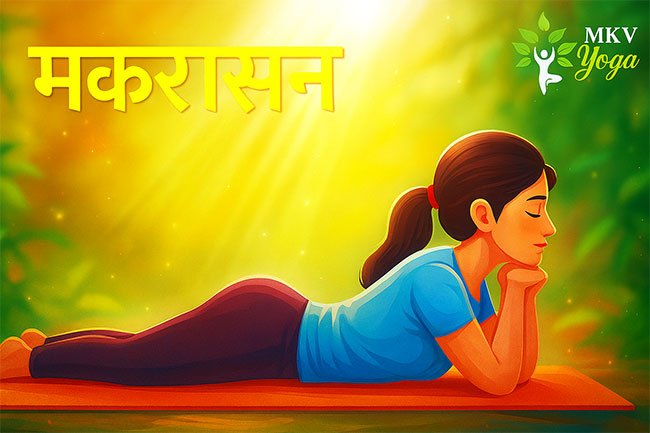Table of Contents
Makarasana – Crocodile Pose Yoga – Steps & Benefits
Makarasana (मकरासन), also known as the Crocodile Pose, is a deeply relaxing yoga asana that primarily benefits the back and spine. Among the many makarasana benefits, it is especially effective for back pain, slipped disc, and sciatica. It also supports people suffering from asthma, bronchitis, and digestive issues.
Simple and beginner-friendly, Makarasana helps release tension, improve breathing, and restore natural balance in the body. The name comes from two Sanskrit words: Makar (crocodile) and Asana (pose). The posture resembles a crocodile resting in water, keeping its face and neck above the surface.
Makarasana Steps
Follow these simple steps to perform Makarasana correctly:
-
-
Spread a yoga mat and lie flat on your stomach.
-
Raise the head and shoulders and rest the chin in the palms, with elbows placed on the ground.
-
Close your eyes and relax the entire body.
-
Remain in the final position for as long as comfortable.
-
To release, become aware of your body, breath, and surroundings.
-
Slowly bring the body back to the starting position.
-
Makarasana Procedure & Key Points
1. Position of the Elbows
-
If elbows are too far forward → stress may occur in the neck joint.
-
If elbows are too close to the chest → tension will build in the lower back.
-
The best position is where both neck and spine feel fully relaxed.
2. Breathing Awareness
Breathing plays a vital role in enhancing the effects of Makarasana:
-
On inhalation, move awareness up the spine from the tailbone to the neck.
-
On exhalation, move awareness down from the neck to the tailbone.
-
Visualize the breath gently massaging the spine in both directions.
For those with lower back pain, focus awareness on the affected area, imagining it expanding and relaxing with each breath. This can relieve pain and tension effectively.
Makarasana Contraindications
-
People with severe back conditions should avoid practicing if discomfort or pain is felt.
-
Always practice under guidance if recovering from an injury.
Makarasana Benefits
Practicing Makarasana regularly offers multiple health advantages:
-
-
Provides deep relaxation to the spine and nervous system.
-
Relieves back pain, slipped disc, and sciatica.
-
Reduces compression of spinal nerves.
-
Helps manage respiratory disorders such as asthma and bronchitis.
-
Activates the body’s healing energies when combined with breathing awareness.
-
Gently massages abdominal organs and supports digestive health.
-
Relieves neck and shoulder pain.
-
Enhances lung capacity and supports a healthy respiratory system.
-
Crocodile Pose Yoga Sequence
Makarasana is a resting yoga pose and is often practiced:
-
After backward-bending asanas like Bhujangasana, Salabhasana, or Dhanurasana.
-
Before counterposes such as Pawanmuktasana or Marjari Asana.
FAQs on Makarasana Benefits
1. What are the main makarasana benefits?
Makarasana relieves back pain, improves spinal health, supports breathing, and relaxes the body.
2. Can beginners practice Makarasana?
Yes, it’s a simple and beginner-friendly yoga pose that requires minimal effort.
3. Is Makarasana good for asthma patients?
Yes, Crocodile Pose helps relax the chest and improves lung function, making it beneficial for asthma and bronchitis.
4. How long should I hold Makarasana?
You can hold it for 3–5 minutes or longer, depending on comfort.
5. Are there any contraindications?
People with severe back injuries should avoid or modify this pose under expert supervision.

